INTRODUCTION
The goal of this work is to determine the appropriateness of chronological
development of the masonries and their parameters in Winston-Salem’s
buildings; as well as to create the masonries’ dating scales for this town.
The historical buildings in Winston-Salem have been dated with
"The Official Guide Book" (see bibliography), which was
used for the buildings and masonries dating as a most recent and most
reliable source. So the methodology suggested in this work, can be
used practically in a case of alterations on the buildings with masonry
additions (for instance, infilling the door or window openings with brick,
later erection of new walls, etc.). Such a case happened in Single Sisters’
House, where number of brick alterations was done in the early 1840s.
The base of the work was a set of data, which was accumulated through a
field research that was done in May-June 2004. Samples of the material
collection are represented
here,
where the selected inspection forms are shown. The same inspection forms
were filled in at a site for each masonry. Such a methodology was
successfully used before for similar researches in Moscow (Russia) and
Philadelphia (PA).
The research covers almost all the brick houses in Winston-Salem, but cannot
be considered as a comprehensive one. It was basically done on elevations,
so the dating precision could be reduced for the interior walls. (For
instance, the type of joint usually is different on the exterior and
interior wall surfaces).
The united terminological system for the historical architectural details
has not elaborated for USA yet. To avoid confusion of reading this text
use the
illustrated glossary with the selected terms.
Arches, foundations, special decorative patterns, fireplaces, chimneys,
horizontal masonry sections and also vaults were not involved in the current
research. The masonries that were used to infill the frame structures of the
frame buildings also were not included in the given analyzes.
Application program “Analize-It” (version 1.69) was used for the statistical
analyzes.
Using the dating methodology, we should always consider that the real
chronological time period can be wider than it was determined with the
research, because not all the historical buildings have survived
(graphic #1).
DESCRIPTION OF THE MASONRY PARAMETERS
18th century mortar is off-white with a slightly grey shade. In the
19th century a mortar color was changed to off-white, with pinkish and
reddish shades. The highest concentration of red pigment is in the mortar of
the original (1861) part of the African Moravian Church, which has red
color, slightly lighter of brick. Brick powder could be added to the mortar.
One of the future investigations goals should be dedicated to determining
whether the outside surface was pointed with red mortar at the façade side
or if it was used over the entire masonry. In the first case it has a pure
decorative function; in the second case a brick powder was added to mortar
to increase its strength.
 The
building’s elevations in Winston-Salem did not have developed 3-dimentional
decorative details. Absence of them was compensated using a black header
pattern (figure #1). The black header bricks were produced at special
locations in a brick kiln. After removing them from the stoves, the bricks
appeared as regular size bricks with glossy black header surfaces. Black
surface was slightly turned over (figure #2) to the four adjacent sides
(about ½”). Used for the facade surface the Flemish masonry black headers
were organized in a special kind of ornament. Together with the regular red
stretchers they created an ornamental decorative effect on a flat wall. The
walls erected with the black headers were more expensive than the walls with The
building’s elevations in Winston-Salem did not have developed 3-dimentional
decorative details. Absence of them was compensated using a black header
pattern (figure #1). The black header bricks were produced at special
locations in a brick kiln. After removing them from the stoves, the bricks
appeared as regular size bricks with glossy black header surfaces. Black
surface was slightly turned over (figure #2) to the four adjacent sides
(about ½”). Used for the facade surface the Flemish masonry black headers
were organized in a special kind of ornament. Together with the regular red
stretchers they created an ornamental decorative effect on a flat wall. The
walls erected with the black headers were more expensive than the walls with
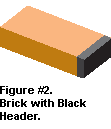 entire red surfaces. That is why some of the buildings’ different facades
had different kinds of decorations. For instance, Winkler Bakery house has
only three elevations decorated with black headers: North, West and South.
East elevation, oriented to the back yard and unavailable for the public
view, contains regular red headers. entire red surfaces. That is why some of the buildings’ different facades
had different kinds of decorations. For instance, Winkler Bakery house has
only three elevations decorated with black headers: North, West and South.
East elevation, oriented to the back yard and unavailable for the public
view, contains regular red headers.
 Black headers were stopped in use in the 1810s, and in the 1820s they were
not used on the brick buildings anymore. Chronologically last building where
black headers can be Black headers were stopped in use in the 1810s, and in the 1820s they were
not used on the brick buildings anymore. Chronologically last building where
black headers can be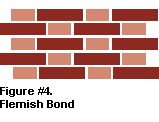 seen is Laundry (1816) where black headers were located sporadically and did
not create any special pattern.
seen is Laundry (1816) where black headers were located sporadically and did
not create any special pattern.
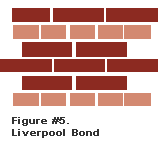 Type of Bond is not actually a pattern. It is one of the main
structural elements of a building. The pattern is a sign of a bond, like a
temperature is not a sickness but one of the Type of Bond is not actually a pattern. It is one of the main
structural elements of a building. The pattern is a sign of a bond, like a
temperature is not a sickness but one of the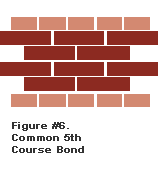 symptoms of a particular
disease. A pattern allows us to judge masonry’s type, the structure and its
features, such as layout or strength. symptoms of a particular
disease. A pattern allows us to judge masonry’s type, the structure and its
features, such as layout or strength.
Together with English Cross bond (figure #3) the Flemish bond
(figure #4) was considered as the strongest and structurally the most stable
bond. At the same time more complicated and more expensive Flemish bond had
higher decorative characteristics. That is why a lot of the front walls of
buildings could be laid with Flemish bond and all the others – with
Liverpool bond. Two buildings in Winston-Salem were created such a way:
South Hall North addition (1824) and Anna Johanna Vogler house (1827).
 The Liverpool bond (figure #5) was used in Winston-Salem in the
1820-1840s (registered cases). The latest use of a Flemish bond was in 1831
(Wash-Bake house, 463 Church St.). The determined time period changing from Flemish bond to the others was during the late 1820s and early 1830s.
The Liverpool bond (figure #5) was used in Winston-Salem in the
1820-1840s (registered cases). The latest use of a Flemish bond was in 1831
(Wash-Bake house, 463 Church St.). The determined time period changing from Flemish bond to the others was during the late 1820s and early 1830s.
The
Common 5th course bond (figure #6) was used widely in the 1840s through
1860s.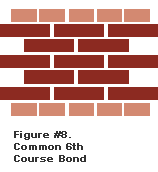
The Running bond (figure #7) started to be used in the mid of
the 19th century (not only in Winston-Salem, but around the USA). It has
been one of the most popular bonds abroad (in the Western world) and it is
named there as the “American Bond”.
The
Common 6th course bond (figure #8) started being used commonly in
the USA during  the 1870s and also received the name “American Common bond”
in the Western construction cultures. This kind of masonry became popular at
the same
the 1870s and also received the name “American Common bond”
in the Western construction cultures. This kind of masonry became popular at
the same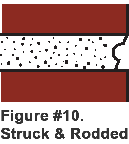 time when machine made production of brick and use of Portland
cement as a component of a mortar have started. Machine made brick had much
higher density and strength. Adding Portland cement to a mortar also
increased strength of a masonry and made it physically compatible to a
brick. time when machine made production of brick and use of Portland
cement as a component of a mortar have started. Machine made brick had much
higher density and strength. Adding Portland cement to a mortar also
increased strength of a masonry and made it physically compatible to a
brick.
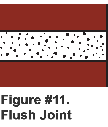
The Type of a joint plays a significant role in dating of masonry.
The Flush & Rodded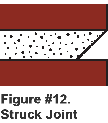 type (figure #9) was used in the 18th and early
19th century in Winston-Salem. The last registered time of using this joint
is 1816 (Laundry House). type (figure #9) was used in the 18th and early
19th century in Winston-Salem. The last registered time of using this joint
is 1816 (Laundry House).
The next chronological type was Struck (figure #12), which in the 1810-1820s also could be Rodded, but later it
appeared as pure Struck. Struck and
 Rodded (figure #10) typicallly
was used only on a main elevation. For instance, the Rodded (figure #10) typicallly
was used only on a main elevation. For instance, the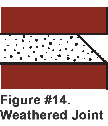 Eastern façade of
Vogler House (700 South Main Street, 1819) was pointed with Struck and
Rodded joint. All the other elevations were pointed with pure Struck joint:
it was cheaper for the owner. Eastern façade of
Vogler House (700 South Main Street, 1819) was pointed with Struck and
Rodded joint. All the other elevations were pointed with pure Struck joint:
it was cheaper for the owner.
Changing from Flush to Struck did not happen at one day. Flush
type existed together with slightly made, not deep struck. Over the time Struck became deeper and deeper until finally appeared as a pure struck
joint type (Figures #11-13).
 Together with Flush and Struck, the Weathered type of joint (figure
#14) could be used on both interior and exterior surfaces of a wall. Like
struck type of joint it was not deep in the 18th century and appeared full
developed by the 1830s.
Together with Flush and Struck, the Weathered type of joint (figure
#14) could be used on both interior and exterior surfaces of a wall. Like
struck type of joint it was not deep in the 18th century and appeared full
developed by the 1830s.
In the second third of the 19th century Double Struck
type of joint (figure #15) existed for a few decades. It was done with a
trowel and appeared as a corner in section.
DATING METHODOLOGIES
Two dating methodologies are suggested in this work. One of them is logical.
It uses visual characteristics of a masonry and logical operation of them.
Another one is dating with formula. None of them can be recommended as a
preferable method. Anyone can select the one that she of he are more
comfortable with. Experienced people can date masonry without using any of
them.
The Dating formula was created using a database, which was collected
from each building with a specially developed form. Multiple
regression methodology was involved to calculate the formula. Particular
parameters of masonry are the members of the dating formula. The square of
correlation coefficient (R2) is 0.93. It means that 93% of cases are
described with this formula. This is a very high value, which does not
happen too frequently in historical statistical research.
Y=37.1336—0.3025x1+0.5720x2—2.5173x3+2.0737x4—2.6443x5-0.1443x6+3.6709x7+2.5082x8
Where:
Y – Dating (codes, table #1)
Variables:
x1 – Joint width (inches)
x2 – 10 courses with 10 joints (inches)
x3 – Brick length (inches)
x4 – Brick width (inches)
x5 – Brick height (inches)
x6 – Type of joint: 1 – Flush+Rodded,
2 – Weathered
3 – Struck+Rodded
4 – Double Struck
5 – Struck
x7 – Black header pattern: 1 – yes, 2 – no
x8 – Type of Bond:
1 – Flemish
2 – Liverpool
3 – Common 5th course
4 – Running
5 – Common 6th course.
Table #1. Codes for Dates
Time Period Code Time Period Code
1601-1605 1
1751-1755
31
1606-1610 2
1756-1760
32
1611-1615 3
1761-1765
33
1616-1620 4
1766-1770
34
1621-1625 5
1771-1775
35
1626-1630 6
1776-1780
36
1631-1635 7
1781-1785
37
1636-1640 8
1786-1790
38
1641-1645 9
1791-1795
39
1646-1650 10
1796-1800
40
1651-1655 11
1801-1805
41
1656-1660 12
1806-1810
42
1661-1665 13
1811-1815
43
1666-1670 14
1816-1820
44
1671-1675 15
1821-1825
45
1676-1680 16
1826-1830
46
1681-1685 17
1831-1835
47
1686-1690 18
1836-1840
48
1691-1695 19
1841-1845
49
1696-1700 20
1846-1850
50
1701-1705 21
1851-1855
51
1706-1710 22
1856-1860
52
1711-1715 23
1861-1865
53
1716-1720 24
1866-1870 54
1721-1725 25
1871-1875
55
1726-1730 26
1876-1880
56
1731-1735 27
1881-1885 57
1736-1740 28
1886-1890 58
1741-1745 29
1891-1895
59
1746-1750 30
1896-1900
60
The Excel application program could be suggested for
simplifying the calculation process.
Different kinds of bonds had different technological
ways to meet the edges, i.e. corners of a
house, door and window jambs, pilasters, etc. Flemish bond, as the most
complicated one, had the biggest number of corner types. Eight of
them were found in Winston-Salem. Sometimes more than one different types of
corner were used on the same building. For instance, Vogler house has two of
them: the First type was used for windows and house corners and the Fourth
one was used for the front door. Three types were registered on the Laundry:
First one for the front door, Third for the back door and Fourth for the
windows. Corners for Liverpool, Common 5th course, Running and Common 6th
course types of Bond are shown in the attachment #3.
IMPORTANT NOTE
Each time when we try to date a particular masonry we should remember about
a possibility of reusing an older brick from the demolished buildings or
their parts. That is why using only the brick sizes, color or surface
character is not recommended for dating. The best way is to use all the
parameters of masonry. The type of bond, mortar characteristics and type of
joint can be considered as the most reliable signs, because they cannot be
reused. Using them for a masonry dating is absolutely essential.
At the very beginning of a physical investigation of any particular building
the local dating scales should be created based on the documentary dated
parts, even if it is only for a single building. That relates not only to
the brick parts, but also to all other details (doors, windows, floors,
moldings, etc.), which can help to date the masonries.
|